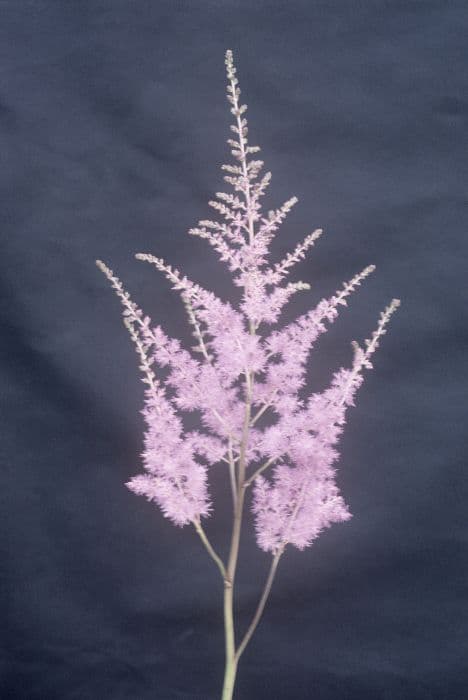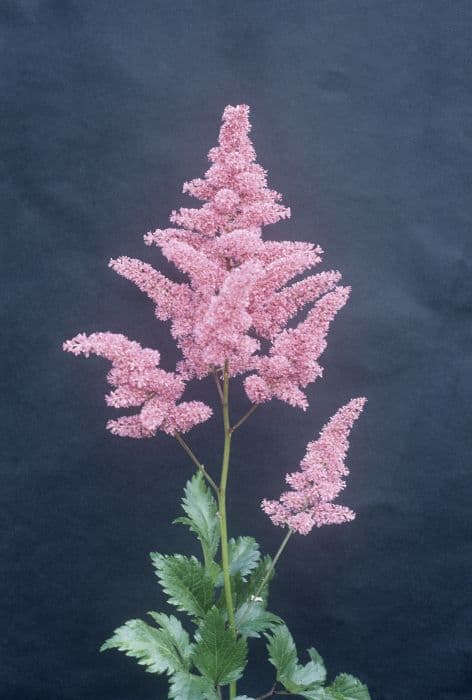Coral Bells Heuchera 'Sugar Plum' (PBR)

ABOUT
Heuchera 'Sugar Plum' is a captivating perennial plant known for its decorative foliage and delicate blooms. The plant boasts ruffled leaves that exhibit a unique combination of colors, transitioning from deep purples to silvery plums with an underlying hint of deep green. These tonal variations add a multi-dimensional aspect to the foliage, making it a standout in any garden setting. Throughout the growing season, the leaves maintain their vibrancy and can glisten as if dusted with sugar when dew or light touches them, enhancing their "sugar plum" namesake. Come spring and early summer, the plant sprouts slender stems that rise above the foliage, adorned with tiny bell-shaped flowers. These blossoms are typically a light, airy pink or pale purple, adding a touch of whimsy and color contrast to the darker leaves below. The flowers attract butterflies and hummingbirds, enriching the garden with wildlife. The plant is a versatile garden choice, ideal for adding texture and contrast to borders, rock gardens, or as an accent in mixed containers.
About this plant
 Names
NamesFamily
Saxifragaceae
Synonyms
Coral Bells, Alumroot
Common names
Heuchera 'Sugar Plum' (PBR)
 Toxicity
ToxicityTo humans
The Heuchera, commonly known as Coral Bells, is generally recognized as a non-toxic plant to humans. Ingestion of its parts typically does not result in poisoning or severe adverse symptoms. However, as with any plant, individual sensitivities can vary, so caution should be taken.
To pets
Coral Bells are also considered non-toxic to pets, such as cats and dogs. If pets consume parts of the plant, they are unlikely to experience symptoms of poisoning. It's always wise to monitor pets if they ingest plant material to ensure they do not have an unusual reaction.
 Characteristics
CharacteristicsLife cycle
Perennials
Foliage type
Evergreen
Color of leaves
Mixed
Flower color
Pink
Height
1-2 feet (30-60 cm)
Spread
1-2 feet (30-60 cm)
Plant type
Herb
Hardiness zones
4
Native area
North America
Benefits
 General Benefits
General Benefits- Ornamental Appeal: Heuchera 'Sugar Plum' adds aesthetic value with its colorful foliage and delicate flowers.
- Year-Round Interest: It provides visual interest throughout the seasons due to evergreen or semi-evergreen leaves in most climates.
- Low Maintenance: This plant requires minimal care once established, making it ideal for busy gardeners.
- Drought Tolerance: Once mature, Heuchera 'Sugar Plum' is quite drought-tolerant, requiring less frequent watering.
- Pest Resistance: It is generally resistant to common garden pests, reducing the need for chemical treatments.
- Attracts Pollinators: The flowers of Heuchera 'Sugar Plum' attract butterflies and hummingbirds, supporting local ecosystems.
- Versatility in Landscaping: Suitable for borders, groundcover, and container gardening, this plant can fit into various garden designs.
- Shade Tolerance: It can thrive in shady areas where other plants may struggle to grow.
- Soil Flexibility: Heuchera 'Sugar Plum' can adapt to a range of soil conditions, though it prefers well-draining soil.
- Deer Resistance: The foliage is not favored by deer, offering a great choice for areas with deer pressure.
 Medical Properties
Medical PropertiesThis plant is not used for medical purposes.
 Air-purifying Qualities
Air-purifying QualitiesThis plant is not specifically known for air purifying qualities.
 Other Uses
Other Uses- Container Gardening: Heuchera 'Sugar Plum' can be used in container gardens to add a splash of color with its attractive foliage.
- Edging Plants: The compact size of Sugar Plum makes it suitable for edging in garden beds, creating a neat, aesthetic border.
- Fantasy Gardens: Create a whimsical, fairy-tale setting by incorporating Sugar Plum heuchera into miniature gardens or fairy gardens due to its colorful leaves.
- Foliage for Flower Arrangements: Its leaves can be cut and used in floral arrangements for their unique color and texture.
- Ground Cover: Planting Sugar Plum en masse can create an effective ground cover, reducing weed growth and soil erosion.
- Landscape Contrasting: Due to its unique plum-colored foliage, it serves as an excellent contrast when planted with green-leaved plants.
- Seasonal Decoration: Sugar Plum's vibrant foliage makes it suitable for seasonal outdoor displays during autumn.
- Garden Art Accompaniment: The plant's colorful leaves can complement garden sculptures or art installations.
- Thematic Gardens: This heuchera variety can be part of a purple-themed garden or a gothic garden design.
- Photography: Its distinctive appearance makes Sugar Plum a picturesque subject for garden photography and plant portfolios.
Interesting Facts
 Feng Shui
Feng ShuiThe Coral Bells is not used in Feng Shui practice.
 Zodiac Sign Compitability
Zodiac Sign CompitabilityThe Coral Bells is not used in astrology practice.
 Plant Symbolism
Plant Symbolism- Beauty and Grace: 'Sugar Plum' cultivars of Heuchera, commonly known as Coral Bells, have a delicate and graceful appearance, reminiscent of ballet dancers. Their ruffled leaves and subtle colors can symbolize beauty and a gentle gracefulness.
- Longevity: Coral Bells are perennials, returning year after year, which makes them a symbol of longevity and enduring presence in a garden space.
- Bountifulness: With their abundant and long-lasting blooms, Coral Bells represent bountifulness and generosity.
- Versatility: Given the adaptability of Coral Bells to different lighting conditions and soils, they are often seen as a symbol of versatility and resilience.
 Water
WaterCoral Bells should be watered deeply to encourage root growth but allow the soil to dry out between waterings. During the growing season, aim for about 1 inch of water per week, which could translate to about 0.6 gallons for a medium-sized plant. Always check the top layer of soil for moisture—when it feels dry to the touch, it's time to water again. Overwintered plants require less water; reduce the frequency to prevent root rot, especially if they are in a non-draining container.
 Light
LightCoral Bells prefer partial shade to full shade conditions, thriving best when they are protected from the intense heat of the afternoon sun. A spot that receives morning light and dappled sunlight throughout the day is ideal. They can tolerate more sun in cooler climates as long as they are kept well-watered.
 Temperature
TemperatureCoral Bells are hardy and can survive in temperatures as low as 0°F and as high as 80°F. However, they thrive best when daytime temperatures are between 65°F and 75°F. To ensure the health of the plant, avoid exposure to extreme temperatures for prolonged periods.
 Pruning
PruningCoral Bells should be pruned to remove any damaged or dead foliage and to maintain their mounded shape. Pruning is best done in the spring before new growth starts. Additionally, spent flower stalks can be cut back after blooming to tidy up the plant and sometimes encourage a second flush of flowers.
 Cleaning
CleaningAs needed
 Soil
SoilCoral Bells 'Sugar Plum' prefers well-draining soil rich in organic matter with a pH range from 6.0 to 7.0. A good soil mix for this plant would be equal parts garden soil, peat moss, perlite, and compost to ensure both moisture retention and proper drainage.
 Repotting
RepottingCoral Bells 'Sugar Plum' typically need repotting every 3 to 4 years, or when you notice that the growth has slowed down due to root crowding in the container.
 Humidity & Misting
Humidity & MistingCoral Bells 'Sugar Plum' thrives best in moderate humidity levels, but it is tolerant of a range of conditions and does not require high humidity.
 Suitable locations
Suitable locationsIndoor
Place Coral Bells 'Sugar Plum' in bright, indirect light with good air circulation.
Outdoor
Grow in part shade, with moist, well-drained soil and some afternoon shade.
Hardiness zone
4-9 USDA
 Life cycle
Life cycleHeuchera 'Sugar Plum', commonly known as Coral Bells, begins its life as a seed, which, when sown in early spring, germinates within several weeks given the right light and temperature conditions. The seedling stage follows germination, characterized by the emergence of the plant's first true leaves, after which the plant enters a vegetative growth phase, developing a clump-forming habit with mounds of scalloped leaves. As it matures, typically within the first year, it produces tall flowering stalks with small bell-shaped flowers, adding ornamental value and attracting pollinators. After blooming, which occurs from late spring to early summer, the flowers may be deadheaded to encourage additional flowering and prevent self-seeding. The plant settles into a perennial cycle, with foliage remaining year-round in warmer climates, or dying back in winter to re-emerge in spring in cooler zones. Coral Bells may be divided every 3-4 years to maintain vigor and prevent center die-back, thus continuing its lifecycle.
 Propogation
PropogationPropogation time
Spring to Summer
Heuchera 'Sugar Plum', commonly known as Coral Bells, is often propagated by division, which is the most popular method for this perennial plant. The best time for the division is in spring when the plant is emerging from dormancy or in late summer after the flowering period. To propagate by division, carefully dig up the plant, ensuring a substantial root ball remains intact. Then, gently tease apart the crowns to create smaller clumps, each with a portion of the root system. Each division should have at least three to five shoots for best results. Replant the divisions immediately, spacing them about 12 to 18 inches (30 to 45 centimeters) apart to provide enough room for growth. Water the newly planted divisions thoroughly to help establish them.









